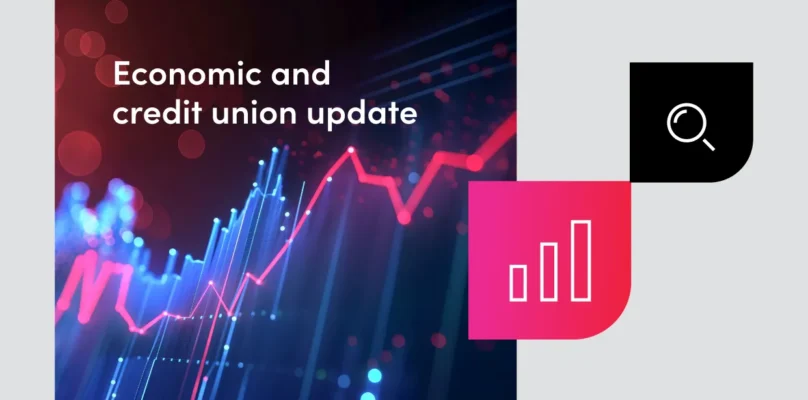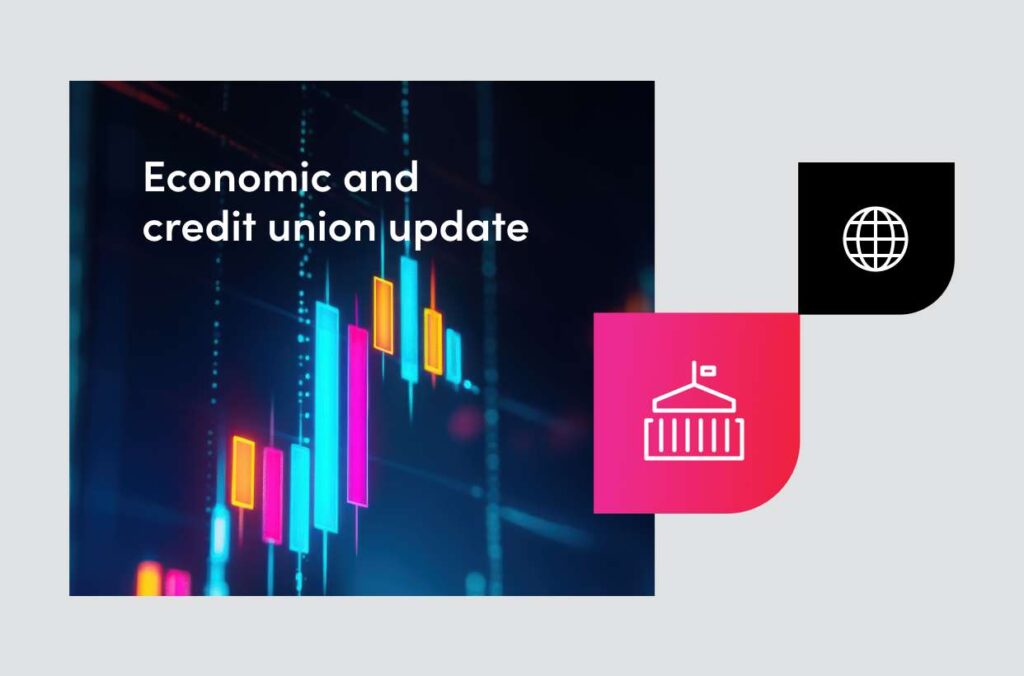Key credit union metrics are projected to return to normal performance levels in 2025, according to Steven Rick, director and chief economist at TruStage™, during a February webinar as he assessed current and future economic considerations.
Understanding the motivation of the Federal Reserve Board’s monetary policy and its impact on credit union lending, delinquency, liquidity, and growth adds context to current performance and influences forecasts for the coming year. Additionally, several well-publicized initiatives of the new presidential administration could significantly affect inflation, GDP, and deficits. Lastly, several other potential risks are identified that could materially impact economic stability and influence future credit union strategy.
Impact of Federal Reserve policies
Interest rates are the primary tool available to the Federal Reserve Board as it tries to influence monetary policy. Most economists agree that 3% represents a neutral interest rate—a rate that accounts for 2% inflation and 1% real equilibrium and one that seeks to neither stimulate nor slow down the economy. In the wake of a big economic stimulus that brought interest rates close to zero a few years ago, post-pandemic inflation has triggered the Fed to respond with the fastest increase in interest rates in 40 years, reaching a high point of 5.35% in July 2023. As inflation has cooled down, the Federal Reserve Board has also started to ratchet rates. Currently, at 4.3%—the debate continues regarding the speed of future potential cuts and how long it might take to drop an additional 1.3% to achieve their targeted balance point.
Higher interest rates mean credit unions are currently experiencing the slowest loan growth since the fallout from the great recession of 2008-09. The current annualized loan growth rate of 3% falls well below the historical average of 7%. Loan balances are expected to continue to grow in the coming year, increasing to 5% but still coming in short of normal. Remember that low interest rates in 2022 contributed to an explosive burst in growth, increasing credit union loan balances by more than 19% that year. The amortization of those seasoned loans is a headwind working against loan balance growth today.
Loan growth and challenges
In addition to the restrictive posture of the federal reserve, tight liquidity is also contributing to modest loan growth performance. The credit union loan-to-asset ratio may be down from a peak of more than 72% but remains historically high at 70.4% and well above the long-run average of 64%. Worth noting is an apparent historical correlation suggesting cyclical high loan-to-asset ratios preceding a recessionary period. Credit union surplus funds (cash and investments) currently are near 6%, lower than the long-run average and another indication of tight liquidity.
New car loan balances help to clearly illustrate the impact of the Fed’s restrictive monetary policy and higher rates. Loan balances from new car sales actually shrunk at credit unions by -8.1% last year. This particular loan balance metric tends to be cyclical, and it is not the first time new car loan balances have fallen, but previous episodes have been associated with poor car sales figures during a recession. Other market conditions currently contribute to the lackluster new car loan origination, including fierce competition from finance companies and the natural runoff and amortization of the lending boom transactions from a few years ago. Incidentally, as supply chain delays are subsiding and the Federal Reserve has started to bring rates down, seasonally adjusted new vehicle sales in the U.S. are creeping back up to near-normal levels after a period of short supply. New cars are also cheaper today than they were a year ago. This normalization may help with consumer affordability but is also putting some downward pressure on collateral values. Looking forward, credit union new car loan balances are expected to reverse their decline and turn the corner, beginning to rebound in the second half of 2025.
For credit unions, used car lending is their bread and butter, and credit unions have experienced uninterrupted growth in used car loan balances for decades, with a long-run average of 7.5% growth until 2024. Last year this critical metric for credit unions shrank by more than 3%. This is something new—something credit unions haven’t seen in recent memory. The same factors that stymied new car lending were in play, high interest rates, strong competition, and amortization headwinds combined to limit opportunities for new loans to replace the runoff from seasoned loans and grow the portfolio. Used auto loan balances are also expected to rebound somewhat in 2025, but shrinking balances in both new and used auto loans have made loan growth a challenge overall in the past year.
In brighter news, credit card balances are up a little bit. A modest 1.7% growth is well below the long-run average of 5.5%. Consumers are responding to some of the highest credit card rates in recent years by avoiding credit card debt and paying down their balance. This is another example of the consequences of a restrictive rate policy causing consumers to limit spending as a tool to rein in inflation.
Saving the day for credit union lending in 2024 were home equity loan products, which grew at an annualized rate of 15.5%, nearly double the 8% long-run average. The “locked-in effect” of homeowners who acquired a 3% fixed-rate first mortgage may motivate families to renovate, expand, and improve their current homes rather than move. Additionally, housing overall remains in short supply, and home prices are skyrocketing, creating a wealth effect of available equity for homeowners to draw against.
Credit union first mortgage loan balances are small but growing again at a 5% pace, rebounding from zero growth a year or so ago. Circling back to the lackluster growth rate of overall credit union combined loan balances over the past year, real estate lending has carried the ball to overcome shrinking new and used car loan performance and keep the total loan balance number moving in the right direction, albeit modestly.
With current unemployment statistics nearly half a point below a full employment target rate of 4.5%, demand for labor is currently higher than supply. Wages grew by 4% in 2024 because of that pressure. However, credit union loan delinquencies are also currently moving up at 1%—higher than the norm of 0.75% and trending in the wrong direction. Increased delinquency is especially noticeable with lower-income members and sub-prime auto loans. Credit union charge-offs are higher than normal, too, at 0.79%—well above a natural charge-off rate of 0.5%.
A variety of factors are contributing to these elevated delinquency statistics. Wages may have grown by 4%, but in a 7% inflation environment, falling real wages continue to put pressure on household budgets. Housing costs are typically the biggest line item in a housing budget and rent inflation has outpaced wage growth by a considerable margin. Student loan deferments are ending, and some members are poorly prepared for that adjustment. Consumers are the ones paying those higher interest rates on car loans, HELOCs, and credit cards. On top of that, they are also paying higher insurance premiums as the value of cars and homes skyrocketed, and premiums are catching up. Some members may even be tempted to drop protection for the collateral, another risk for credit unions.
In addition to the influence of the Federal Reserve and the market impacts of interest rates, other factors can potentially affect the credit union’s economic climate. The new administration in Washington has proposed, or is already implementing, several new initiatives. It may be too soon to say how big a role tariffs will play in the new administration’s economic strategy, but there is general agreement that higher tariffs will result in inflationary pressure and lower GDP, perhaps balanced to a degree by bringing down deficits with tariff revenues collected.
The new administration is expected to extend and perhaps expand the 2017 tax cuts and Jobs Act, set to expire soon. Additionally, proposals have been put forward to eliminate income tax on tips, overtime, and social security benefits. Both initiatives would be likely result in higher inflation and deficits, albeit with some potential benefits to GDP.
Finally, the new administration promises to pursue deregulation, cutting red tape, eliminating redundancy, and creating new efficiencies in federal government operations. Not surprisingly, the potential benefits of such accomplishments could be positive for credit unions, including lower inflation, lower deficits, and higher GDP. The first half of 2025 may offer some indication of the potential success of this initiative.
Overall, economic growth in the U.S. is healthy, and economists are not forecasting a recession at this time. A 2% growth rate might be considered natural or organic growth, combining 1% population growth with a 1% increase in productivity. The economy grew at a rate of 2.5% in 2023 and 2.8% last year but is expected to settle back to 2.4% this year and normalize further to 2.0% in 2026.
Future economic risks and opportunities
A variety of risks could temper that optimism. While the Federal Reserve Board policy appears to have set the economy up for a soft landing, a cautious approach could stifle new loan growth by being too slow to lower rates. Both the stock market and home prices have seen rapid escalation and are at or near record highs. A big decrease in either the stock market or home values could throw a wrench in the Fed’s plan. Wars in both Eastern Europe and the Middle East have the potential to cause disruption, as would a significant rise in energy prices. Lastly, there is growing concern about commercial real estate performance, particularly lower-quality office space hampered by high vacancy rates, depressed rents, and decreasing property values.
Overall, the Federal Reserve Board’s efforts to combat inflation with a restrictive monetary policy have throttled credit union loan growth opportunities in 2024. That pressure is expected to ease somewhat as the Fed approaches its 2% target inflation rate. The risk of a recession appears to be low at this point, and credit unions are forecast to make incremental progress toward closing the gap to normal growth rates in loans, deposits, and capita.













